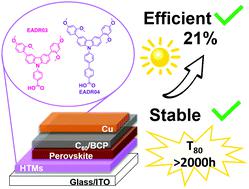当前位置:
X-MOL 学术
›
Energy Environ. Sci.
›
论文详情
Our official English website, www.x-mol.net, welcomes your feedback! (Note: you will need to create a separate account there.)
Understanding the perovskite/self-assembled selective contact interface for ultra-stable and highly efficient p–i–n perovskite solar cells
Energy & Environmental Science ( IF 32.5 ) Pub Date : 2021-5-21 , DOI: 10.1039/d0ee03807e Ece Aktas 1, 2, 3, 4, 5 , Nga Phung 6, 7, 8 , Hans Köbler 6, 7, 8 , Dora A. González 1, 2, 3, 9, 10 , Maria Méndez 1, 2, 3 , Ivona Kafedjiska 8, 11, 12 , Silver-Hamill Turren-Cruz 6, 7, 8 , Robert Wenisch 8, 11, 12 , Iver Lauermann 8, 11, 12 , Antonio Abate 6, 7, 8, 13, 14 , Emilio Palomares 1, 2, 3, 15, 16
Energy & Environmental Science ( IF 32.5 ) Pub Date : 2021-5-21 , DOI: 10.1039/d0ee03807e Ece Aktas 1, 2, 3, 4, 5 , Nga Phung 6, 7, 8 , Hans Köbler 6, 7, 8 , Dora A. González 1, 2, 3, 9, 10 , Maria Méndez 1, 2, 3 , Ivona Kafedjiska 8, 11, 12 , Silver-Hamill Turren-Cruz 6, 7, 8 , Robert Wenisch 8, 11, 12 , Iver Lauermann 8, 11, 12 , Antonio Abate 6, 7, 8, 13, 14 , Emilio Palomares 1, 2, 3, 15, 16
Affiliation

|
Current perovskite solar cell efficiency is close to silicon's record values. Yet, the roadblock for industrialization of this technology is its stability. The stability of the solar cell not only depends on the stability of the perovskite material itself but also notably on its contact layers and their interface with the perovskite, which plays a paramount role. This study rationalizes the design of new molecules to form self-assembled monolayers as a hole-selective contact. The new molecules increased the stability of the perovskite solar cells to maintain 80% of their initial PCE of 21% for 250 h at 85 °C under 1 sun illumination. The excellent charge collection properties as well as perovskite passivation effect enable the highly stable and efficient devices to demonstrate the vast potential of this new type of contact in photovoltaic application.
中文翻译:

了解钙钛矿/自组装选择性接触界面对于超稳定和高效的p–i–n钙钛矿太阳能电池
目前的钙钛矿太阳能电池效率已接近硅的创纪录值。然而,这项技术产业化的障碍是其稳定性。太阳能电池的稳定性不仅取决于钙钛矿材料本身的稳定性,而且尤其取决于其接触层以及它们与钙钛矿的界面,这起着至关重要的作用。这项研究合理化了新分子的设计,以形成自组装单分子层作为空穴选择性接触。新分子增加了钙钛矿太阳能电池的稳定性,在1个阳光照射下于85°C下250 h保持其初始PCE的80%为21%。
更新日期:2021-05-22
中文翻译:

了解钙钛矿/自组装选择性接触界面对于超稳定和高效的p–i–n钙钛矿太阳能电池
目前的钙钛矿太阳能电池效率已接近硅的创纪录值。然而,这项技术产业化的障碍是其稳定性。太阳能电池的稳定性不仅取决于钙钛矿材料本身的稳定性,而且尤其取决于其接触层以及它们与钙钛矿的界面,这起着至关重要的作用。这项研究合理化了新分子的设计,以形成自组装单分子层作为空穴选择性接触。新分子增加了钙钛矿太阳能电池的稳定性,在1个阳光照射下于85°C下250 h保持其初始PCE的80%为21%。


























 京公网安备 11010802027423号
京公网安备 11010802027423号